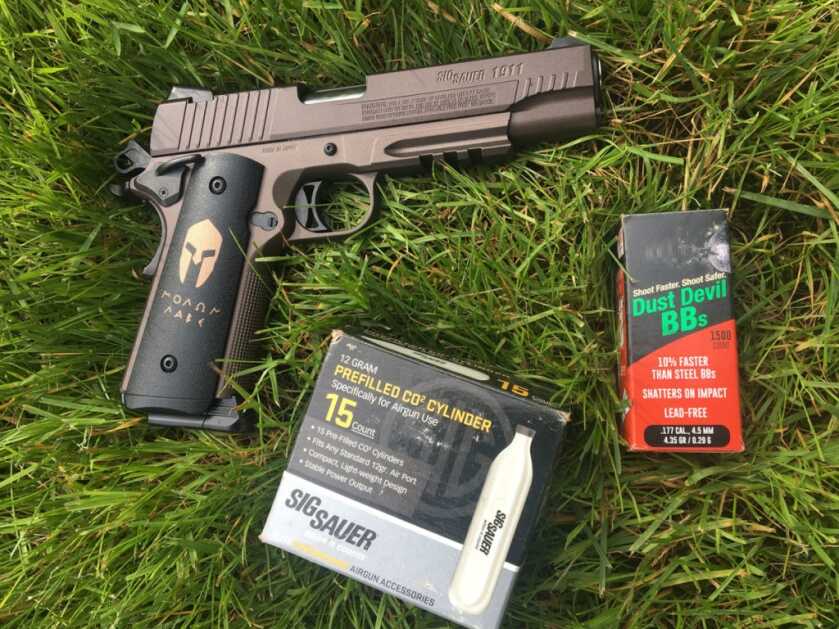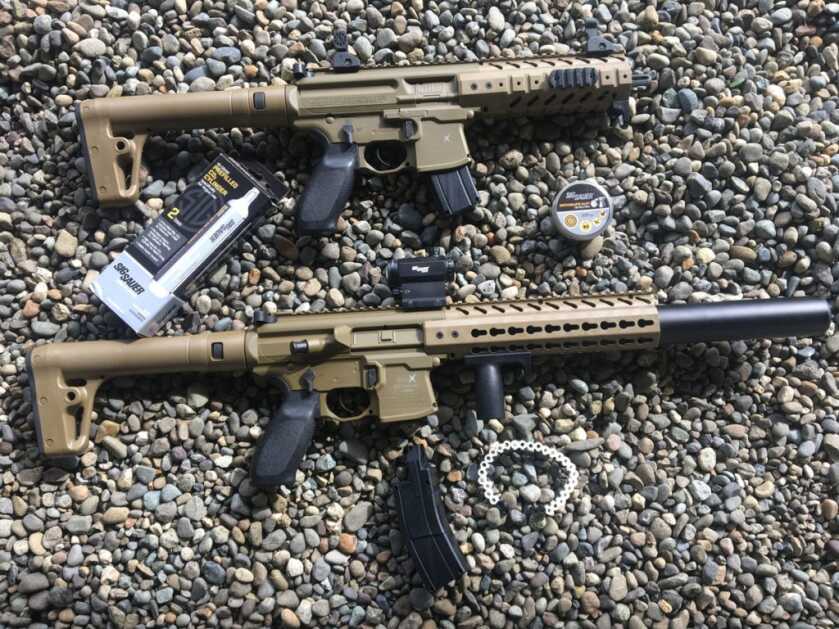By Mark Miller
Police officers, competitive shooters, and military units train with air guns. What do they know that you don’t? It is safer and cheaper than live fire while measurably improving performance. There is no better way to teach trigger control and reduce anticipation of recoil.
The cost of range training is more than just the ammunition. We must also include vehicle mileage, targets and range fees but perhaps the most precious resource consumed is time. While training at home can never completely replace range time, shooting an air gun can be the vital addition to help you get the trigger time you need. Air guns can mirror your real guns and let you train tasks at home which might not be allowed on your range like drawing from the holster, shooting on the move and using cover.
Many shooters view air guns as toys, but they can be very precise and allow inexpensive high-quality training in convenient venues. The NRA has a whole section of their website dedicated to airguns. https://homeairgun.nra.org/
Value
So, what is the value of air gun training? The single biggest challenge of marksmanship is the anticipation of recoil. Virtually every shooting error can be traced back to this condition. Shooting a quiet and low recoil system like an air gun will avoid the startle flinch reflex which causes anticipation of recoil and induces movement into the gun.
There are air guns which model most of the handguns on the market. If you are a SIG shooter, you are in luck, SIG makes their own line of air guns which exactly match the size, weight, and balance of their handguns.
Sight alignment and trigger control are the two essential fundamentals. Without noise, blast and recoil you can focus on the subtleties of technique. Air guns are the very best way to teach new shooters and kids. They are fun, non-lethal, quiet and can be safely fired in backyards and basements.
There are air guns which fire single shots and magazine fed guns which fire semi-auto. The single shot models have their place, they are inexpensive, reliable, can be very accurate. Presentation and the first shot can be practiced using the same holster as your real carry pistol. With magazine fed guns, you can use reactive targets and practice target to target transitions, even moving targets.
Air guns can be shot safely indoors; there is no need to travel to the range to practice. All you need is about 15 feet of backyard, basement or hallway with a pellet trap. You can support any type or training you need. There are many BB and pellet traps on the market.
Targets and Pellet Traps
The good news is that you don’t need to buy a pellet trap, you can make a simple and inexpensive trap from a cardboard box. Pack the back two-thirds of the box with magazines or folded newspapers and tightly pack the front of the box with crumpled newspapers. Overlap the materials and make sure they do not settle and fill the corners. Close and tape up the box, then mark the side with the crumpled newspapers and put your target on that side.
A box trap is ideal for capturing and containing fired BBs. BBs have a tendency to bounce and ricochet out of steel traps. The stuffed cardboard box captures them. I have been known to reuse undamaged BBs.
CO2 Powered Air Guns
The ideal training gun would be as close to your duty or defense weapon as possible. If, for example, you carry a 1911, the 1911 Spartan BB Pistol features a full metal slide and frame with realistic blowback action of the metal slide and a 16-round magazine that holds 4.5mm steel BBs. The Spartan also fits in most 1911 holsters and has the same weight and controls of a traditional 1911 firearm.
This high-performance air pistol, like most realistic air guns, is powered by CO2, either from a 12-gram cartridge or a bulk CO2 tank. A CO2 power plant is used in both mass-produced, non-precision airguns and in the highest quality 10-meter match airguns.
Magazine fed pistols and rifles can fire pellets or BBs, some will shoot both. BBs have been ignored in the past because they are prone to ricochet. Air Venturi’s Dust Devil frangible BBs allow the use of realistic action BB pistols for training with moving reactive targets.
SIG makes easy to load belt fed CO2 powered versions of their MCX and MPX carbines and rifles. At short ranges, they are quite accurate and fun to shoot. They use big 90-gram gas cartridges in the stock and have plenty of endurance.
The performance of CO2 guns is greatly affected by temperature. At room temperature, a CO2 cartridge produces about 1000 psi and is very consistent. A temperature shift will change the point of impact of a CO2 air gun and reduce the number of rounds a cartridge of gas will fire. A C02 cartridge will last, depending on the temperature, from 60 to 100 shots.
Spring Piston Air Guns
When most people think of air guns they probably picture a spring piston gun. Spring-piston airguns can be inexpensive the easiest air guns to shoot and maintain. They are cocked by breaking the barrel or cocking a lever. 
These guns only fire one round, but they are perfect for marksmanship training. They force good follow through because the pellet stays in the barrel longer. If you move to soon, you will be off target. They can be very accurate and challenging to shoot.
Cocking the action or breaking the barrel moves a piston within the receiver as it compresses a spring behind it. The trigger sear clicks into a notch in the piston and holds the whole works under tension until the trigger is activated.
To load, the pellet is placed directly into the breech and the barrel is swung into position. When you release the safety and press the trigger, the sear releases the piston. It slams forward under spring power pushing a column of air into the rear end of the pellet sitting in the breech. The pellet engages the rifling in the barrel and flies out the barrel towards the target.
This produces a forward then backward motion. The shooter feels a smooth steady recoil as the spring pushes the pellet out the barrel. This movement can break conventional rifle scopes. If you are going to use optics, get a special airgun scope.
Spring-piston airguns are very reliable and can serve for decades. I have a Beeman P-1 pistol which is still shooting tiny groups after 34 years of training. It even went to Afghanistan with me. Another treasure is an East German made Haenel rifle with target sights and a stock which looks like it is made out of pine. After 30 years it still shoots better than I can hold. Both of these troopers should outlive me.
The new made in America ASP20 break barrel air rifle from Sig takes this proven technology to a whole new level. Clever engineering has reduced cocking effort by half and the trigger, usually an afterthought in these guns is superb. The MatchLite trigger two-stage trigger system can be adjusted to break at one of eight different pull rates – from 2.5 to 4 pounds – allowing users to select the break that’s most comfortable for them. The trigger breaks at 4mm, regardless of the pull rate selected.
Pneumatic Air Guns
Pneumatic airguns use compressed air for power. The most common type of pneumatic air gun is the pump airgun many of us had as kids. Pre-Charged Pneumatic (PCP) airguns use a compressor filled storage tank as an air source.
These modern PCPs provide amazing accuracy, easy loading, no recoil and lots of shots from each air charge. The downside is that some support gear is required. You need a SCUBA tank (3000 psi) or a Carbon Fiber tank. (4500 psi). The air gun tank is filled from the SCUBA tank by a special adaptor hose. PCPs come in various configurations and calibers, some big enough to hunt large game. There are single shot versions while others feature multiple-shot magazines.
One of the most popular PCPs is the AirForce Airguns Condor SS. I have been shooting mine for a year now. It has replaced .22 in my training and I shoot in my basement with no lead contamination. Designed for quiet small game hunting, the CondorSS combines Sound-Loc® reduction technology and the 18-inch barrel work together to deliver 90-foot-pounds of energy in .25 caliber. It is accurate enough to shoot one hole at 10 yards and I have found it effective on pests beyond 25 yards.
The Pay Off
Learning to shoot is a rewarding journey. The challenges are daunting but the rewards are many. Whether your goal is a precision shot for hunting or defending yourself and family, you need that edge that only practice can provide. Airgun training is an excellent way to train beginning shooters or build trigger and manipulation skills for advanced shooters.
For safety, cost, availability and convenience, there is no other technology which can compete. You can find great deals on air guns right here on GunsAmerica: https://www.gunsamerica.com/Search.aspx?Keyword=airguns
https://www.airforceairguns.com/
https://www.sigsauer.com/products/airguns/


You made an apparently blanket statement that air guns are “non-lethal.” All airguns that hurl steel or lead projectiles at several hundred fps can cause serious injury, and some pack enough punch they could do lethal damage to critters considerably bigger than a pack rat. I’m sure you know that, and that all the basic rules of firearm safety apply to airguns as well.
Question- what’s the best quality Glock 17/19 replica air gun and where can I get it?
Sportsmansguide.com has one licensed by Glock that looks exactly like a 19 until very close inspection.
I train daily at home with co2 guns Gives you recoil and report while much safer Massive Kudos to SIG for making ultra quality mirrors of their production arms I switched to Sig bcause of that Great for force on force
Completely glossed over gas powered airsoft guns which can be used for everything above PLUS force on force.
You beat me to it Joshua. The KWA PTP (Professional Training Pistols) are a good choice, but the spare mags are pricey.
Do you find them accurate enough for marksmanship training?